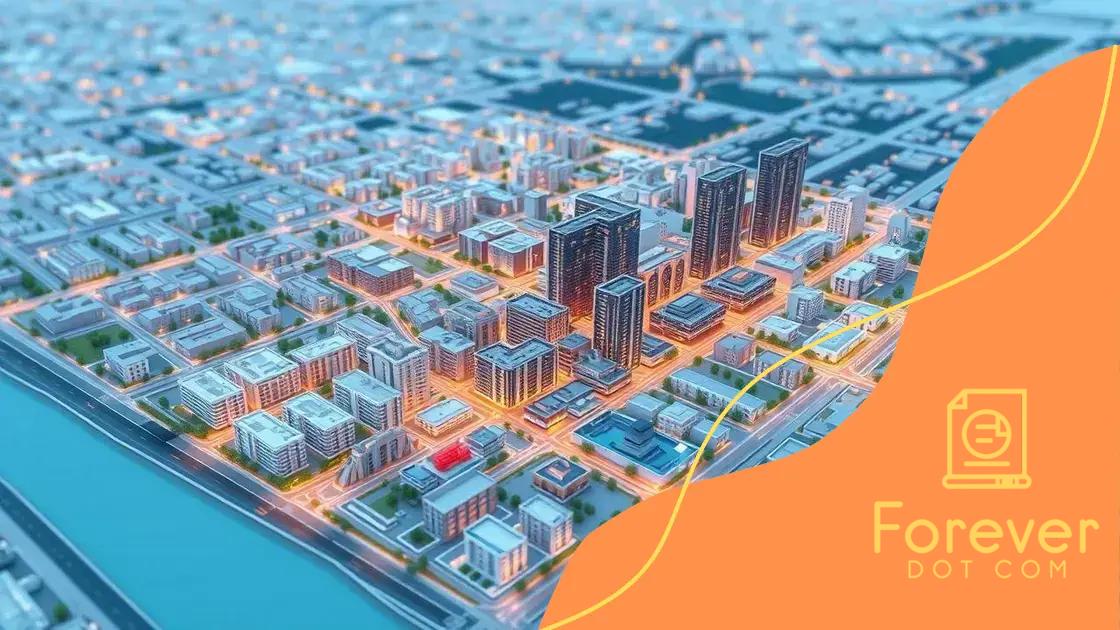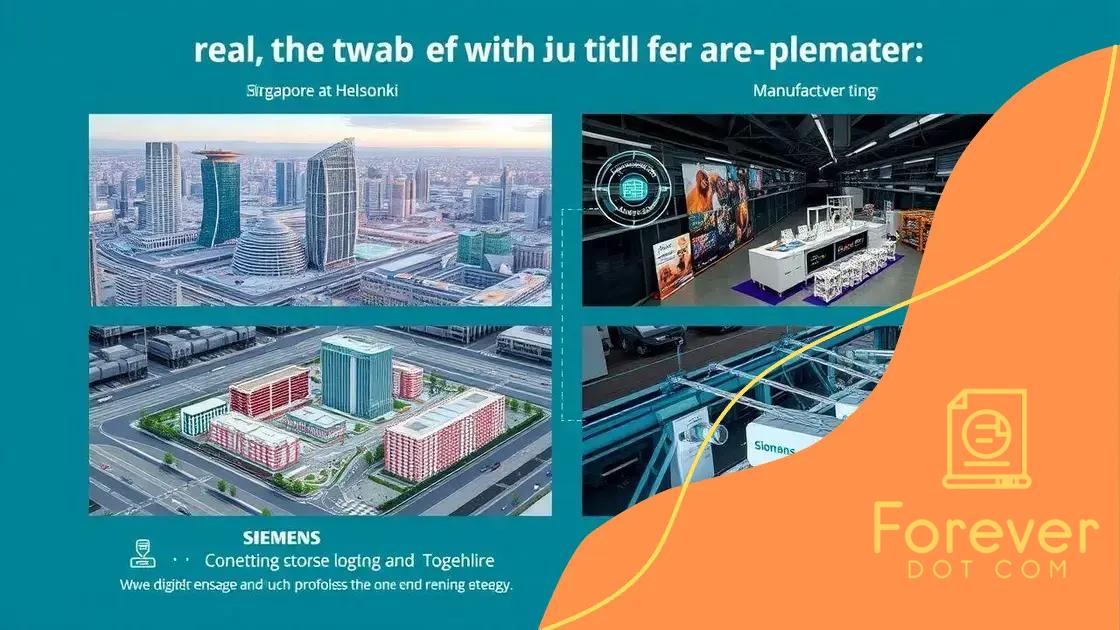The rise of digital twins in urban planning and development

The rise of digital twins in urban planning enhances decision-making, sustainability, and community engagement by creating real-time virtual models that simulate and analyze urban environments.
The rise of digital twins in urban planning and development is transforming how cities are visualized and optimized. Imagine a virtual model of your city, allowing planners to predict outcomes and enhance decision-making. Curious about how this technology is reshaping our urban landscapes?
Understanding digital twins and their applications
Understanding digital twins and their applications opens a world of possibilities in urban planning. Imagine having a virtual model of a city that mirrors real-time changes. This technology is becoming essential for planners and developers.
Digital twins are not just models; they are dynamic representations of physical structures. They collect data and can simulate scenarios to help in decision-making. Planners can visualize how different factors influence urban life, such as traffic flow and resource use.
Key Applications of Digital Twins
One major application is in managing infrastructure. Cities can leverage digital twins to monitor bridges, roads, and utilities, predicting when maintenance is needed.
- Real-time data for infrastructure health
- Enhanced planning for urban growth
- Risk assessment and management
- Support for sustainability initiatives
Another critical area is improving public services. By analyzing various datasets, cities can enhance their response to emergencies and optimize resource allocation. For instance, a digital twin can model the impact of a new park on local traffic and social interactions.
Civil Engineering and Construction
Digital twins offer tremendous advantages in civil engineering. They allow engineers to predict how construction projects will affect surrounding areas and resources. This capability minimizes disruption and promotes efficient use of materials.
As technology advances, digital twins will incorporate more data sources, including IoT devices. This integration provides a more detailed and accurate picture of urban environments, driving better planning outcomes.
In summary, understanding digital twins is crucial for modern urban planning. They enhance various applications, from infrastructure management to public service optimization. As cities continue to evolve, digital twins will play a pivotal role in creating smarter, more sustainable urban environments.
The benefits of digital twins in urban planning
The benefits of digital twins in urban planning are vast and transformative. These advanced models provide cities with insights that lead to better decision-making processes. As urban areas grow, the ability to simulate and analyze changes is crucial.
Digital twins offer real-time data that can improve efficiency in resource management. They help city planners visualize scenarios before making changes in the physical environment. This is especially useful for understanding complex systems, such as traffic patterns and utility management.
Improved Efficiency
One of the major advantages is improved efficiency. Digital twins allow ongoing monitoring of city infrastructure, which can predict failures before they occur. This proactive approach enhances maintenance efforts.
- Real-time updates on infrastructure status
- Reduction in operational costs
- Faster response times to issues
- Data-driven decision making
Another significant benefit is the enhancement of public engagement. Digital twins enable residents to visualize changes and improvements in their communities. This transparency fosters trust between citizens and city officials.
Supporting Sustainability
Sustainability is becoming increasingly important in urban planning. Digital twins contribute by allowing planners to assess the environmental impact of new projects. This technology can simulate how new buildings or parks will affect local ecosystems.
By utilizing digital twins, cities can better plan for sustainable development. They support initiatives like green buildings and optimized energy use. This technology not only makes planning more efficient but also aligns with global sustainability goals.
In conclusion, the benefits of digital twins in urban planning are compelling. From improving operational efficiency to supporting community involvement and sustainable practices, these tools are essential for modern cities.
Real-world examples of digital twin implementation

Real-world examples of digital twin implementation illustrate the practical benefits of this technology across various sectors. Cities around the world are adopting digital twins to enhance planning and operations. These implementations not only improve efficiency but also foster innovation.
One notable example is Singapore, which utilizes a digital twin to manage urban planning and development. This model allows the city to simulate the impact of new buildings and infrastructure on the surrounding environment. It helps planners visualize how changes will affect traffic, weather patterns, and public services.
City of Helsinki
Another example is the city of Helsinki, Finland. Helsinki’s digital twin combines real-time data with 3D models of the entire city. This approach aids in managing city resources, enhancing public service delivery, and optimizing transportation networks. With this tool, city officials can make informed decisions based on accurate data.
- Real-time transportation flow analysis
- Impact assessment of new projects
- Environment and sustainability tracking
- Public engagement and feedback integration
Additionally, Tokyo has implemented a digital twin for disaster management. This model simulates potential earthquakes and aids in emergency response planning. It helps officials coordinate evacuations and resource distribution during crises.
Private Sector Success
Digital twins are not limited to public sectors. Companies like Siemens leverage this technology for manufacturing. Their digital twin models allow for real-time monitoring of equipment. This proactive maintenance reduces downtime and boosts productivity.
In the energy sector, firms like General Electric use digital twins to optimize power generation. These models predict equipment failure, allowing for maintenance before issues arise. This predictive approach not only saves money but also enhances operational reliability.
Through these examples, we see how digital twins can transform urban planning and operational efficiency. By utilizing real-time data and simulations, cities and companies are better equipped to tackle modern challenges, ensuring a more sustainable and responsive environment.
Challenges in integrating digital twins
Challenges in integrating digital twins can impede the full realization of their benefits. While digital twins offer great potential, several obstacles must be addressed for successful implementation. Recognizing these challenges is key to developing effective solutions.
One major challenge is data integration. Digital twins rely on data from various sources, including sensors and databases. Ensuring these systems work seamlessly together can be complex and requires careful planning. If the data is not accurate or up to date, the model will not reflect reality.
High Implementation Costs
Another significant challenge is the high cost of implementation. Creating a digital twin requires advanced technology and skilled personnel. Many cities and organizations may find this financially burdensome.
- Investment in new hardware and software
- Training staff to manage and maintain systems
- Ongoing operational costs
- Potential return on investment uncertainties
Moreover, there is often a lack of standardization across industries. Each sector may have different protocols and systems, making it difficult to create a cohesive model. This lack of uniformity can lead to further complications in data sharing and integration.
Data Privacy and Security
Data privacy and security also pose significant concerns. With increasing amounts of data being collected, it is crucial to ensure that sensitive information is protected. Cities must navigate regulations regarding data use while maintaining public trust.
Lastly, many stakeholders are involved in urban planning and development. Coordinating efforts among various agencies and departments can be challenging. Different goals and priorities may complicate the integration of digital twins into overall planning processes.
By addressing these challenges, cities and organizations can pave the way for the successful integration of digital twins. This will ultimately help harness their potential to create smarter and more efficient urban environments.
Future trends in urban development with digital twins
Future trends in urban development with digital twins will significantly reshape how cities function and grow. As technology advances, the capabilities of digital twins are expanding, and their applications are becoming more integrated into urban planning processes.
One major trend is the increased use of artificial intelligence alongside digital twins. AI can analyze vast amounts of data collected from digital twins, enhancing predictive capabilities. This integration allows for better decision-making regarding urban design and infrastructure maintenance.
Enhanced Environmental Monitoring
Another trend is the emphasis on sustainability. Digital twins will be crucial for monitoring environmental impact in real time. Cities can simulate various development scenarios to see how they might affect the environment.
- Predicting the impact of new buildings on local ecosystems
- Managing green spaces more efficiently
- Optimizing energy consumption in urban areas
- Reducing waste through better resource management
Moreover, the collaboration between cities and technology companies is growing. Partnerships will lead to the development of tailored digital twin solutions that meet specific urban challenges. These partnerships will help cities adapt quickly to changes and improve overall resiliency.
Increased Community Engagement
Public engagement will also see growth through digital twins. City planners will use these tools to visualize proposed changes and gather feedback from residents. This transparency will help build trust between citizens and local governments. By involving communities in planning decisions, cities can foster better relationships and create more inclusive spaces.
In summary, the future of urban development with digital twins looks promising. By leveraging technology and engaging communities, cities can become smarter, more efficient, and better prepared for the challenges ahead. As innovations continue to emerge, digital twins will play an integral role in shaping sustainable urban environments.
FAQ – Frequently Asked Questions about Digital Twins in Urban Planning
What are digital twins?
Digital twins are virtual models of physical objects or systems that use real-time data to simulate their behavior and performance.
How do digital twins improve urban planning?
They provide insights for better decision-making, allowing planners to visualize the impact of changes before implementation.
What are some challenges in integrating digital twins?
Challenges include data integration, high implementation costs, data privacy concerns, and the need for standardization.
What trends can we expect in the future for digital twins?
Future trends include increased AI integration, enhanced environmental monitoring, and greater community engagement in urban development.






